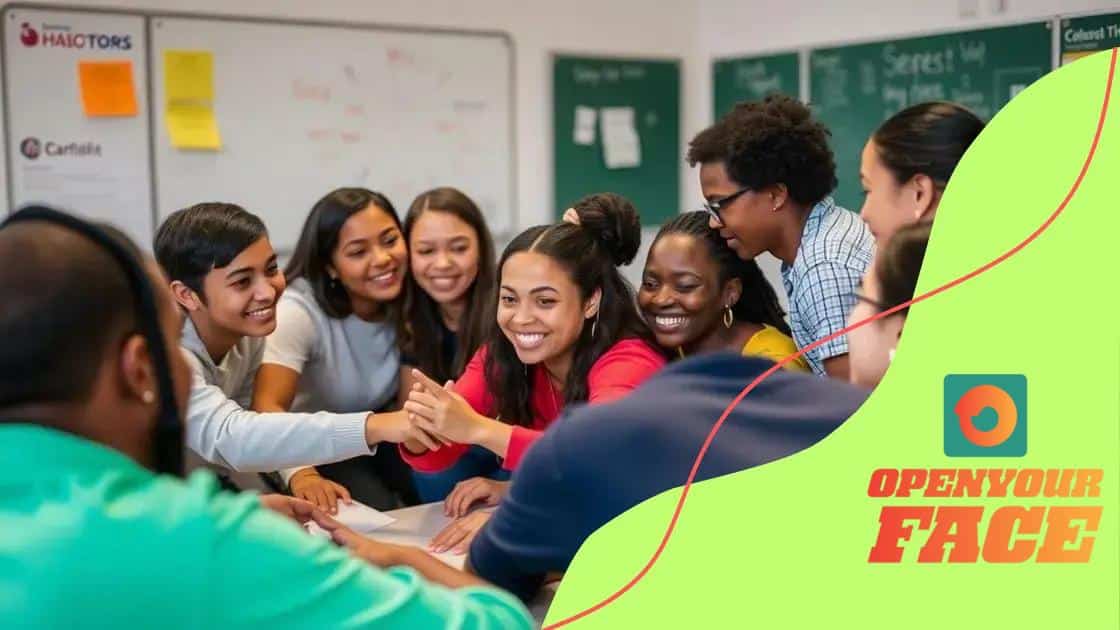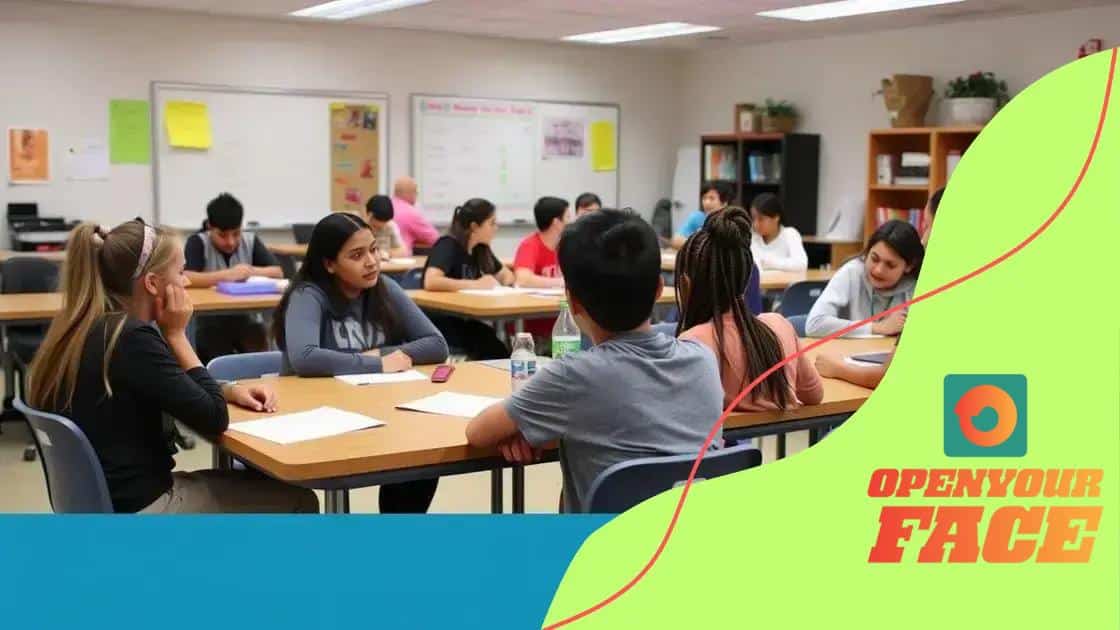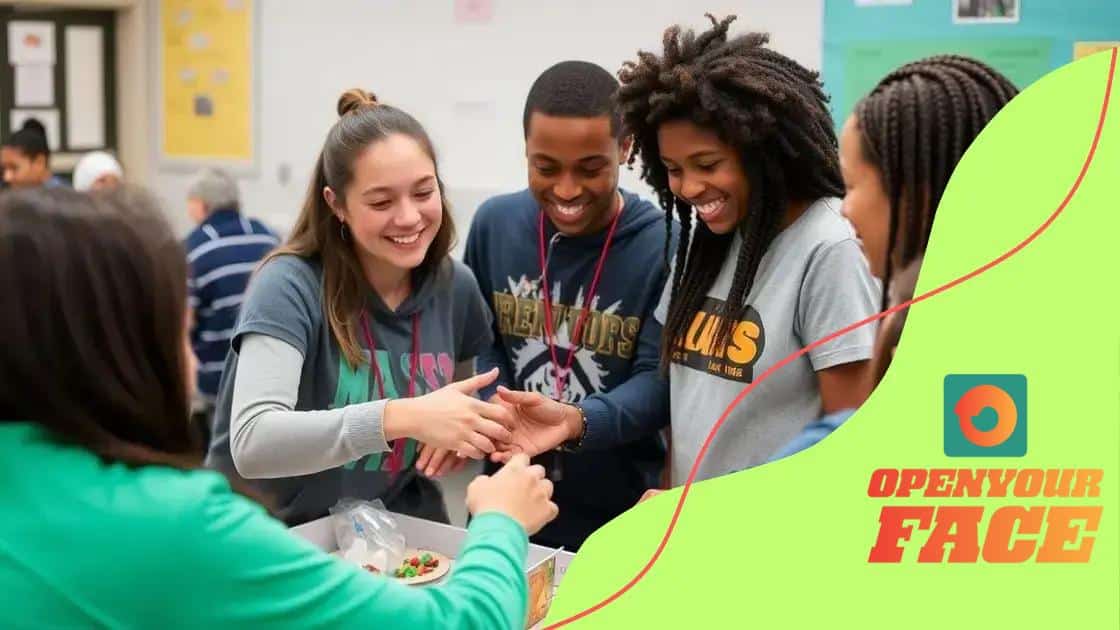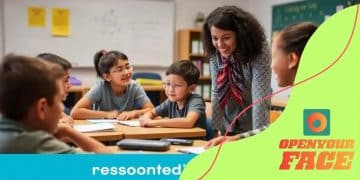The importance of teaching soft skills in schools

The importance of teaching soft skills in schools lies in their ability to enhance students’ communication, teamwork, and problem-solving abilities, which are essential for academic success and future career readiness.
The importance of teaching soft skills in schools cannot be overstated, as these competencies significantly enhance students’ personal and professional lives. Have you ever wondered how learning to communicate effectively or work in teams can shape a child’s future? Let’s dive into why it’s vital.
Understanding soft skills: what are they?
Understanding soft skills is crucial in today’s world. These are the personal attributes that allow someone to interact effectively and harmoniously with others. Unlike hard skills, which are job-specific and technical, soft skills encompass a range of abilities, such as communication, teamwork, and problem-solving.
What are soft skills?
Soft skills can be defined as the interpersonal skills that help individuals fit in the workplace. They are essential for collaboration and productivity. Here are some key examples:
- Communication: The ability to convey information clearly.
- Teamwork: Working well with others towards a common goal.
- Adaptability: Adjusting to new situations and challenges.
- Emotional Intelligence: Understanding and managing one’s emotions and empathizing with others.
While academic knowledge is important, these skills play a pivotal role in long-term success and job satisfaction. For instance, a student with excellent communication skills can express their ideas more effectively, leading to better collaboration in group projects. Similarly, being adaptable can help students thrive in various situations, making them more appealing to future employers.
The significance of soft skills
Developing soft skills in schools promotes a positive learning environment. It encourages students to engage with their peers, build friendships, and create lasting relationships. Additionally, teaching these skills early on helps students navigate challenging situations later in life.
Furthermore, employers often prioritize candidates who possess strong soft skills, as these are indicators of a candidate’s ability to contribute to a positive workplace culture. By fostering such abilities in schools, we are not only enhancing the academic experience but also preparing students for future success.
Why soft skills matter in education

Soft skills are essential for student development and academic success. These skills, which include effective communication, collaboration, and problem-solving, help students navigate their educational journeys and prepare for future careers. Understanding why soft skills matter in education can dramatically impact a student’s learning experience.
Building Better Communication
Strong communication skills allow students to express their thoughts clearly and address questions confidently. When students learn how to communicate effectively, they can participate in discussions and share ideas more freely. This ability creates a supportive learning environment where everyone feels empowered to contribute.
- Improved Classroom Participation: Students engaged in their learning are more likely to succeed.
- Enhanced Relationships: Good communication fosters positive connections with peers and teachers.
- Conflict Resolution: Students with strong communication skills can better handle disagreements.
Soft skills also contribute significantly to teamwork. As students work together on projects, they learn to value different perspectives and collaborate more efficiently. This collaborative spirit not only fosters creativity but also prepares them for teamwork in the workplace.
Preparing for the Job Market
In today’s competitive job market, employers prioritize candidates with strong soft skills. They want individuals who can adapt to different roles and work effectively in teams. By incorporating soft skills training into education, schools can equip students with the tools they need to thrive in their future careers.
Additionally, when students grasp the importance of soft skills, they become more resilient. They learn to embrace challenges and bounce back from setbacks. This resilience will serve them well, both in school and beyond.
How schools can effectively teach soft skills
Teaching soft skills effectively in schools requires intentional strategies and a supportive environment. Schools can create methods that engage students and encourage them to practice these essential skills regularly. By focusing on interactive learning and real-life applications, educators can help students develop strong soft skills that will serve them throughout their lives.
Integrating Soft Skills into the Curriculum
One effective way to teach soft skills is by integrating them into the existing curriculum. Subjects like language arts and social studies can provide opportunities for students to enhance their communication and teamwork abilities.
- Group Projects: Allowing students to work in teams fosters collaboration and develops interpersonal skills.
- Debates and Discussions: Engaging in conversations helps build confidence and improve critical thinking.
- Reflective Writing: Encouraging students to express their thoughts enhances their emotional intelligence.
Additionally, schools can invite guest speakers from various professions to discuss their experiences and the importance of soft skills in the workplace. This exposure can motivate students to appreciate the value of these abilities.
Creating a Positive Environment
Establishing a supportive classroom culture is vital for teaching soft skills. Teachers can model good communication and teamwork by demonstrating these skills in their interactions with students and peers. A classroom that encourages respect and inclusion allows students to feel safe when practicing new skills.
Moreover, schools can implement programs focused on social-emotional learning (SEL) to address the development of soft skills. SEL programs provide students with the tools to understand their emotions, build relationships, and handle challenges effectively. Through role-playing and group activities, students gain practical experience in applying these skills in real-life scenarios.
Real-life examples of soft skills in action

Real-life examples of soft skills in action show how essential these skills are in everyday settings. Students can learn a lot by observing how effective communication and teamwork play vital roles in various situations. Let’s explore some practical instances.
Group Projects in Class
When students work on group projects, they naturally practice soft skills. For example, they must communicate their ideas clearly and listen to their teammates. Through this process, students learn how to collaborate and respect different viewpoints. They often encounter challenges such as conflicts in opinions, which teaches them how to resolve disagreements respectfully.
Sports Teams and Activities
Participating in sports is another great way to see soft skills in action. On a sports team, players need to cooperate to succeed. They must also understand their roles within the team and support one another. Here are some key skills developed through sports:
- Teamwork: Working together toward a shared goal.
- Leadership: Encouraging teammates and leading by example.
- Discipline: Committing to practice and learning from mistakes.
These experiences shape students’ characters and prepare them for future teamwork in their careers.
Community Service Projects
Engaging in community service also allows students to apply their soft skills in real-world scenarios. In volunteer settings, students learn to communicate with diverse groups, often adapting their communication styles to suit different audiences. They also develop problem-solving abilities as they face unexpected challenges during service projects.
For instance, while organizing a local food drive, students might need to work together to gather resources, promote the initiative, and ensure efficient distribution. Such experiences not only enhance their skills but also foster a sense of responsibility and empathy.
Measuring the impact of soft skills education
Measuring the impact of soft skills education can provide valuable insights into its effectiveness in schools. To understand how these skills benefit students, it’s essential to gather data on various aspects of their growth. Observing changes in students’ behavior, academic performance, and social interactions can help paint a clear picture.
Data Collection Methods
There are several effective ways to measure the impact of soft skills education. Surveys, assessments, and direct observations are commonly used methods. These methods can provide both qualitative and quantitative data, allowing educators to analyze the outcomes.
- Pre- and Post-Tests: Administer tests before and after soft skills training to gauge improvements.
- Surveys: Collect feedback from students, teachers, and parents about changes in behavior and confidence.
- Behavioral Observations: Monitor students in group projects or during interactions to see how they apply their skills.
By combining these data collection techniques, schools can gain a comprehensive understanding of how well their soft skills programs are performing.
Tracking Academic and Social Growth
In addition to direct assessments, schools should track academic performance and social development to determine the broader impact of soft skills education. For instance, students who engage in teamwork may see improvements in grades due to enhanced collaboration and communication with peers.
Furthermore, monitoring social behaviors like increased participation in class discussions or better conflict resolution can indicate success in soft skills education. Teachers can note these changes and share them with administration and parents, showcasing the value of soft skills training.
Ultimately, measuring the impact of soft skills education is essential for continuously improving these programs. As schools refine their approaches based on collected data, they can better prepare students for future challenges in both their personal and professional lives.
In conclusion, teaching soft skills in schools is crucial for preparing students for real-life challenges and success. These skills, which include communication, teamwork, and emotional intelligence, play a significant role in students’ academic and personal lives. By integrating soft skills education into the curriculum and measuring its impact, schools can help students grow into well-rounded individuals ready for the future. Gaining these skills not only benefits students in their education but also makes them more attractive to employers, enhancing their chances of success in the workplace.
FAQ – Frequently Asked Questions about Teaching Soft Skills in Schools
What are soft skills?
Soft skills are personal attributes that help individuals interact effectively with others, including communication, teamwork, and problem-solving.
Why are soft skills important for students?
Soft skills are essential for academic success and future employment, as they improve students’ ability to work with others and adapt to challenges.
How can schools measure the impact of soft skills education?
Schools can use surveys, observations, and pre- and post-assessments to evaluate changes in student behavior and performance.
What are some effective ways to teach soft skills?
Effective methods include integrating soft skills into the curriculum, using group projects, and promoting social-emotional learning programs.






